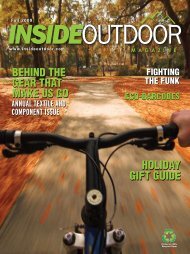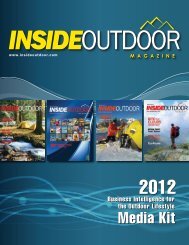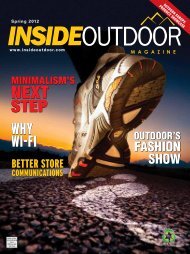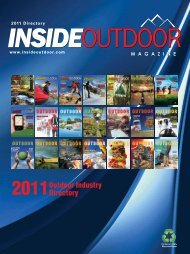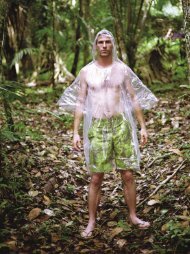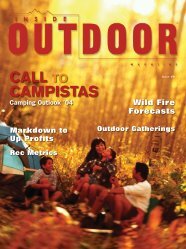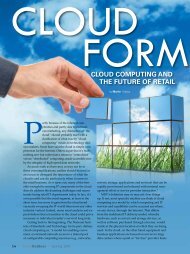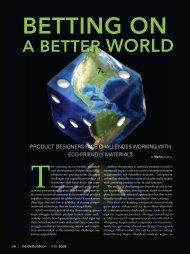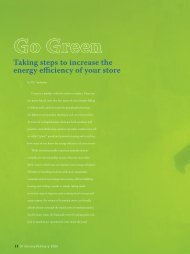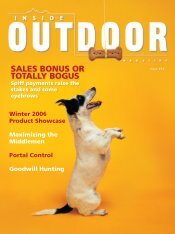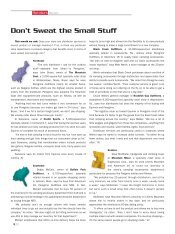Summer - InsideOutdoor Magazine
Summer - InsideOutdoor Magazine
Summer - InsideOutdoor Magazine
You also want an ePaper? Increase the reach of your titles
YUMPU automatically turns print PDFs into web optimized ePapers that Google loves.
The primary reason for the lack of outdoor participation<br />
seems to be a lack of available time, with 71 percent of males<br />
and 64 percent of females saying they do not participate in outdoor<br />
activities because of available leisure time. In all, 44 percent<br />
said they would definitely participate in outdoor activities<br />
if they had more leisure time.<br />
This is at least encouraging. The question now becomes how<br />
to create more leisure time or how to get Hispanics to alter how<br />
they spend their leisure time.<br />
The UCLA/OIF report indicates that the availability of leisure<br />
time in the Hispanic community is actually growing. In<br />
order to capitalize on that time when it becomes available,<br />
outdoor marketers have the challenge of increasing Hispanic<br />
participation now in activities that do not require a large time<br />
commitment, such as trail running, hiking, biking and fishing,<br />
the authors suggest.<br />
“In the future when Hispanics have more time to participate,<br />
the momentum derived from prior outdoor activity involvement<br />
has the potential to encourage further activity in more<br />
time intensive activities,” write the UCLA authors.<br />
In order to capitalize on the interest, the outdoor industry<br />
would be wise to appeal to the social and familial aspects of the<br />
Hispanic community by promoting the social aspects of activities<br />
like hiking, fishing and camping.<br />
“The benefit would be that these activities would not require<br />
more of a time commitment than is already spent with their<br />
family and friends,” notes the UCLA/OIF report.<br />
In addition, marketers have an opportunity to market the<br />
health benefits to these types of outdoor activities. “This might<br />
prove to be an especially good opportunity for parents to spend<br />
time with their children while promoting active lifestyles,” the<br />
authors suggest.<br />
THINK YOUNG<br />
With 19 distinct household segments within the Hispanic<br />
community, marketers need to hone in on those segments which<br />
are most likely to provide the highest return. The UCLA/OIF<br />
study says the most active Hispanics are between 18 and 34 (40<br />
percent are active more than four hours per week). In addition,<br />
38 percent of Hispanics with at least some level of college education<br />
reported activity greater than four hours per week. That<br />
number increases to 41 percent for those Hispanics with an advanced<br />
degree.<br />
In addition, the UCLA/OIF report says 40 percent of males<br />
reported physical activity of more than four hours per week,<br />
compared to just 29 percent of females.<br />
But the most encouraging segment may very well be the Hispanic<br />
youth market.<br />
“The Hispanic market and especially the Hispanic youth<br />
market cannot be ignored by any industry in the U.S. that wishes<br />
to be competitive both today and in the near future,” says the<br />
OIF report. “The sheer size of the Hispanic youth segment and<br />
its incredible growth rate demand immediate attention.”<br />
According to the report, the Hispanic share of the under-18<br />
U.S. population grew from 11.4 percent to 18 percent between<br />
1990 and 2002. This was compounded by a slowing and even<br />
reduction in the number of non-Hispanic youths.<br />
Encouraging for the industry is Hispanic youths appear<br />
to have favorable attitudes toward outdoor activities. In the<br />
UCLA/OIF survey, camping topped the list among those with<br />
at least a medium interest, with 75 percent expressing medium,<br />
high or very high interest. Hiking was second among the most<br />
interested at 55 percent, followed by biking and rock climbing<br />
which both tallied 50 percent medium to very high interest.<br />
Camping and hiking are prime “gateway” activities that<br />
could lead to other pursuits as participants age, and once they<br />
begin having children of their own, they are likely to pass along<br />
their fondness for camping because of its family friendliness<br />
and social benefits.<br />
The other good news for marketers is that younger Hispanics,<br />
regardless of country of origin, are much more likely than older<br />
Hispanics to view English as their dominant language. In addition,<br />
in families with less acculturated parents, kids have a significant<br />
impact on brand purchases, the UCLA/OIF study says.<br />
Some complications are that Hispanic families tend to be<br />
matriarchal, with mothers being the “ultimate gatekeepers”<br />
and teens being shielded from “messages or activities that<br />
are seen as threatening to the family or irrelevant,” note the<br />
UCLA researchers.<br />
Another challenge is that obesity is an issue for the entire<br />
Hispanic population, particularly youths. Research suggests<br />
that there is cultural and social acceptance for being overweight,<br />
but health matters also are a concern for Hispanics, so being<br />
able to promote outdoor recreation as a healthy alternative to<br />
other activities could prove meaningful.<br />
COMMUNICATION<br />
Cultural indicators aside, one of the barriers to entry up<br />
to now has been a lack of meaningful communication about<br />
outdoor recreation to the Hispanic population. Manufacturers<br />
have not done a good job of getting effective messages out, and<br />
retailers can do more within their local communities to cater to<br />
Hispanic consumers.<br />
In their study, the UCLA researchers note that visits to retailers<br />
within or near areas with large Hispanic populations did<br />
not have Spanish-speaking staff available, nor did they provide<br />
promotional literature in Spanish. The effect could be as simple<br />
as out of sight, out of mind. Or worse, alienation.<br />
It stands to reason that those with the best opportunity in<br />
reaching Hispanic consumers are those nearest to the heaviest<br />
concentration of population. Regardless, it appears that a concerted,<br />
cooperative effort between manufacturers, retailers and<br />
other segments of the outdoor industry stands the best chance<br />
in being effective.<br />
All aspects of the industry stand to benefit. The fact there is<br />
clear interest in outdoor activities by Hispanics is an important<br />
and encouraging development. That there is still little participation<br />
is discouraging. The task now is to fix the disconnection.<br />
Instead of continuing to ask why Hispanics aren’t involved<br />
in outdoor pursuits or buying outdoor gear in large numbers,<br />
the latest market research suggests the more meaningful question<br />
is why should they?<br />
There is a lot riding on the answers. Based on the numbers,<br />
that’s a $1 trillion question.<br />
36 | <strong>InsideOutdoor</strong> | <strong>Summer</strong> 2007



